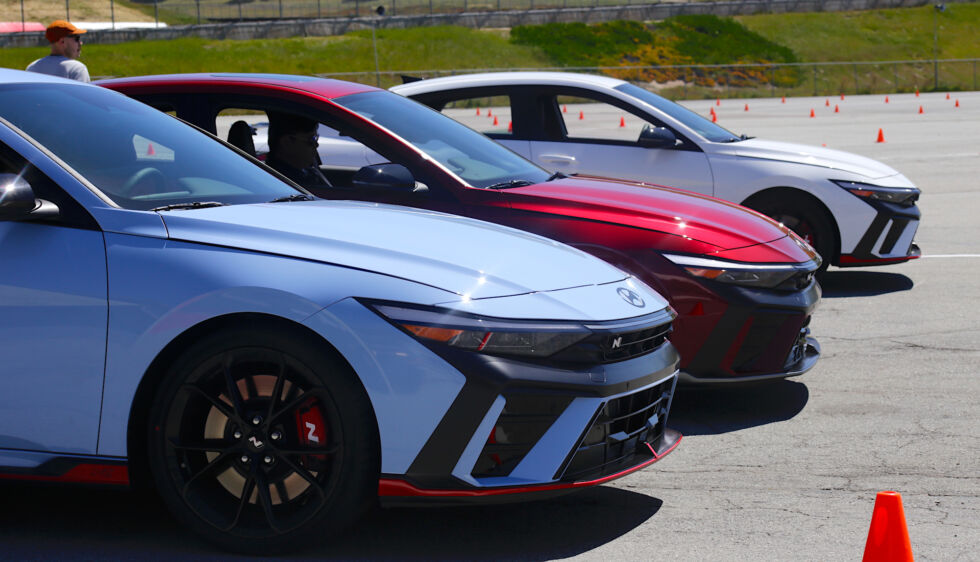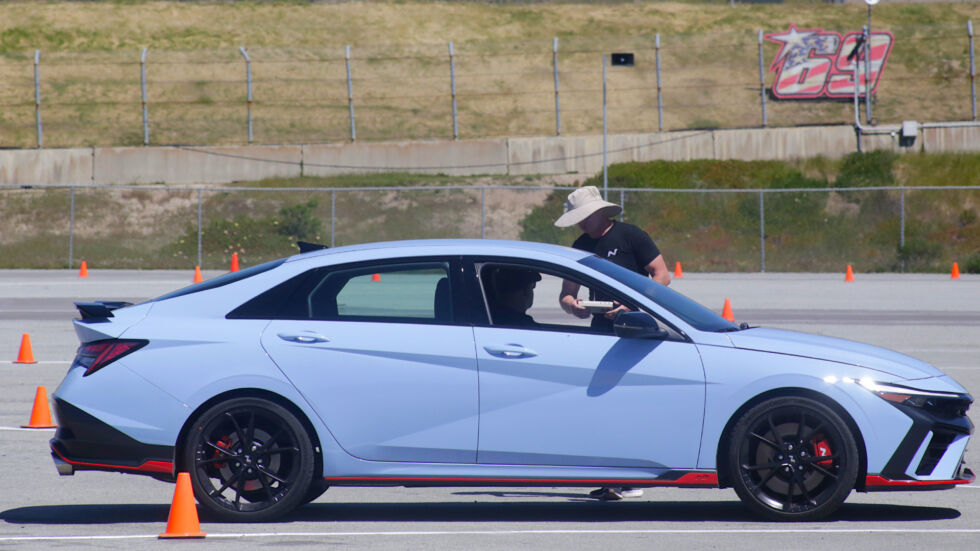Going for a spin
I had the opportunity to drive the 2024 Hyundai Elantra N to my heart's content on canyon roads around Monterey, California, as well as through a short autocross course. First things first: Hyundai nailed one of the top marks of a good sport compact: its sense of occasion.
The direct-injected 2.0 L turbocharged four-cylinder engine sprang to life with a light baritone rasp, sounding eager to get on with it and revving freely.

Its enthusiasm was contagious. Pulling out onto the main road, the Elantra N's engine revved up like a classic, angry turbo-four and double-timed once the tach needle swept past 4,500 rpm. The shifter possessed excellent spring and notch, albeit a longer throw than I'd prefer. The clutch was awfully light and uniform throughout its entire travel, proving hard to make smooth gas/clutch transactions. The gas and brake pedal positioning didn't make for easy heel-toe downshifting, either—auto rev-match is almost a necessity, which might not sit well with purists.
Once on a proper canyon road, the joyful Elantra's rarin'-to-go character shone through. Hyundai says the engine's 276 hp (206 kW) and 285 lb-ft (386 Nm) will propel it to 60 mph (98 km/h) in just over five seconds. Based on how full throttle in second gear felt, I believe that. It's an entertaining power curve, and the six-speed manual's gearing matches it well. Economy is rated at 20 mpg (11.8 L/100 km) city, 27 mpg (8.7 L/100 km) highway, and 23 mpg (10.2 L/100 km) combined for the manual, and 21, 29, and 24 mpg (11.2, 8.1, and 9.8 L/100 km) respectively, for the DCT.
The N's handling high card was its front end, which inspired confidence with plenty of grip. Every degree of movement in the (nicely weighted) steering translated to movement at the nose without being too twitchy, and the steering ratio has been very well-judged. Hyundai says this is thanks to stiffer control arm bushings, plus a new low-friction steering joint and re-tuned electric steering rack.
Body roll was imperceptible at somewhat respectful public road speeds, too, thanks to adaptive dampers bolted up to a MacPherson strut front and multi-link rear suspension. I was impressed by its poise through longer sweeping corners. Previous Hyundai N cars punish the human skeleton in their stiffest setting, N Mode, but thanks to improved rear suspension bushings and a damper re-tune, the latest hot Elantra ironed out choppier bits of tarmac quite well. Keeping everything in control are 14.2-inch (360 mm) front and 12.4-inch (315 mm) rear rotors, which had a decently firm pedal and ample stopping power throughout my time with it.

Later in the day, a short autocross course sealed the deal on the N's tweaks: In spite of some light body roll showing up in its tight, technical path, it still felt precise and easy to place, and its electronically controlled limited-slip differential was a champ at putting the power down.
A deal
The latest 2024 Hyundai Elantra N didn't necessarily need a refresh, but I'm glad Hyundai gave it one anyway. It's a slight bummer that its clutch action and pedal placement aren't quite up to par with the rest of its corner-loving capability, but it's good to have such engagement (and a 100-lb/45 kg drop in curb weight) nonetheless. The Elantra N's position as one of the last great front-wheel drive sport compacts is even more cemented than before, and for anyone after a spacious, economical, and ever-entertaining four-door, you can't go wrong for $35,000 or so.
reader comments
82